The history of usage of dietary spices has its origin probably from the beginning of the human race. Medicinal properties of spices are well established and hence they have been the mainstay of natural remedies throughout the world. Dietary spices have diverse physiologic and metabolic effects on various body systems, which explain their role in traditional therapies. Incorporation of different spices in cooking has been constantly experimented and developed over centuries worldwide. Since spices are such an integral part of all dietary cuisines, they are one of the most common agents to which metallic appliances fixed into oral cavity might get exposed to on a regular basis [1]. Yet, it is surprising to find hardly any studies in literature describing their effects on corrosion of orthodontic appliances. The oral cavity favours corrosion of metallic appliances due to its diverse environment which varies in ionic, thermal, microbiological, enzymatic conditions, temperature and pH [2]. Corrosion and corrosion products have been known to have biological effects in humans. Corrosion in turn may also affect the mechanical properties of the appliances, resulting in their failure. This is of concern particularly when fixed metallic Orthodontic appliances are placed in the oral cavity as they are bound to stay for a prolonged duration of time in hostile environment leading to corrosion. They are complex mixtures of various organic substances and minerals and are suspected to chemically react with metallic components exhibiting an aggressive behaviour leading to corrosion and pitting of surfaces [3]. Thus, it is important to have a comprehensive knowledge of these attributes and the materials need to be selected carefully. Hence, the study was designed to assess and compare the in vitro corrosion of the orthodontic metal brackets immersed in solutions of different spices and salt in artificial saliva.
The null hypothesis thus formed was that there was no effect of spices and salt on corrosion of orthodontic brackets.
Materials and Methods
A pilot study was conducted in the Department of Orthodontics, Bharati Vidyapeeth Dental College and Hospital, Sangli using four most commonly used spices such as Coriander, Turmeric, Black pepper and Red chilli along with Salt. (Dandekar and co., Sangli) . Unused metallic brackets of premolars (to maintain standard surface area) were included in the study.
Based on the study done by Chaturvedi TP conducted in 2014 two samples in each group were taken [3]. The sample comprised of 20 orthodontic metal brackets (0.22 slot, MBT, AO) divided into 10 groups containing two brackets in each group [Table/Fig-1]. Group 1 and group 2 were used as reference solutions.
Groups of samples and their contents.
| Group | Contents |
|---|
| Group 1 | Artificial saliva |
| Group 2 | Artificial saliva+Salt |
| Group 3 | Coriander |
| Group 4 | Coriander+Salt |
| Group 5 | Turmeric |
| Group 6 | Turmeric+Salt |
| Group 7 | Black pepper |
| Group 8 | Black pepper+Salt |
| Group 9 | Red chilli |
| Group 10 | Red chilli+Salt |
The extract preparation was carried out in the Pharmacology laboratory in the college. The powdered spices (50 gm) were mixed with 250 mL of distilled water and refluxed for half an hour and cooled. Later on the solutions were subjected to the filtration procedure using filter paper followed by filtration on silica gel mesh (20-120 mesh) to obtain the aqueous extract as shown in [Table/Fig-2] [3].
Filtration apparatus to obtain aqueous extract.
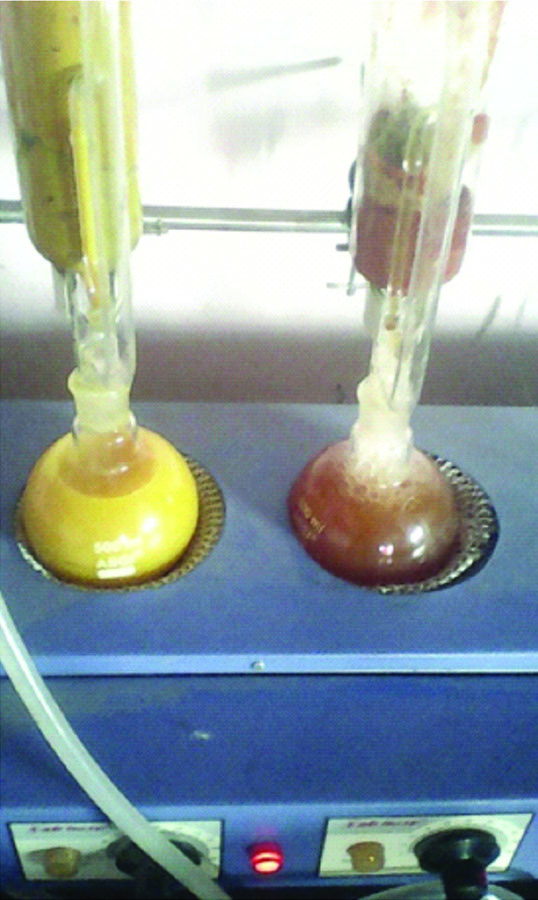
A 20 mL of this extract was mixed with 80 mL of artificial saliva (water, cellulose gum, glycerine, sodium saccharin, parabens) and used as test medium. Similarly, groups containing salt were prepared by adding 1% salt to the above solutions. [Table/Fig-3] shows the aqueous extract solution obtained after addition of artificial saliva.
Aqueous extract of spices.
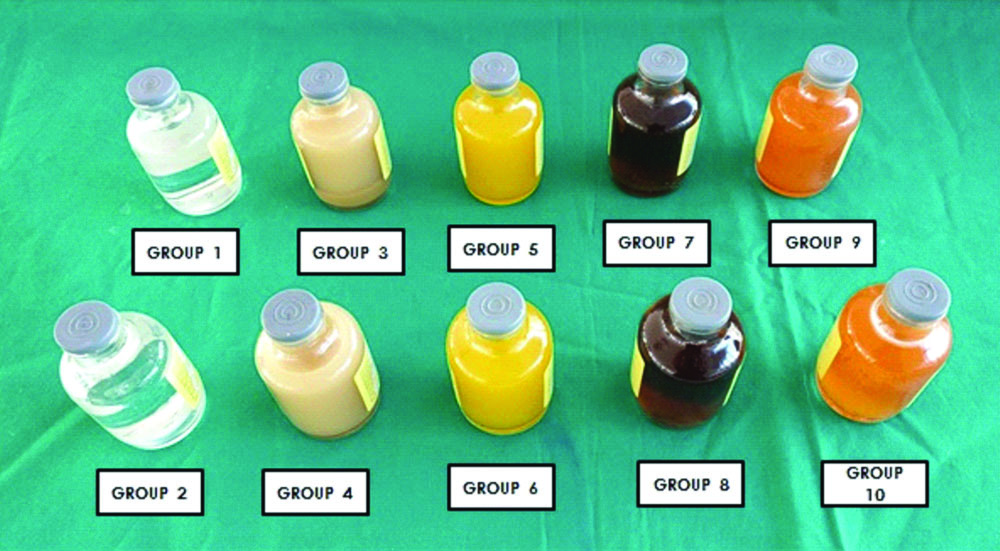
A corrosion cell consisting of a Working Electrode (WE), Reference Electrode (RE) and a Counter Electrode (CE) was used. Preparation of the test sample was done by painting lacquer onto the base of each bracket and the wire connected to it. This was immersed in the corrosion cell containing test medium and connected to the WE for 60 minutes each as shown in [Table/Fig-4].
Electrochemical corrosion cell.
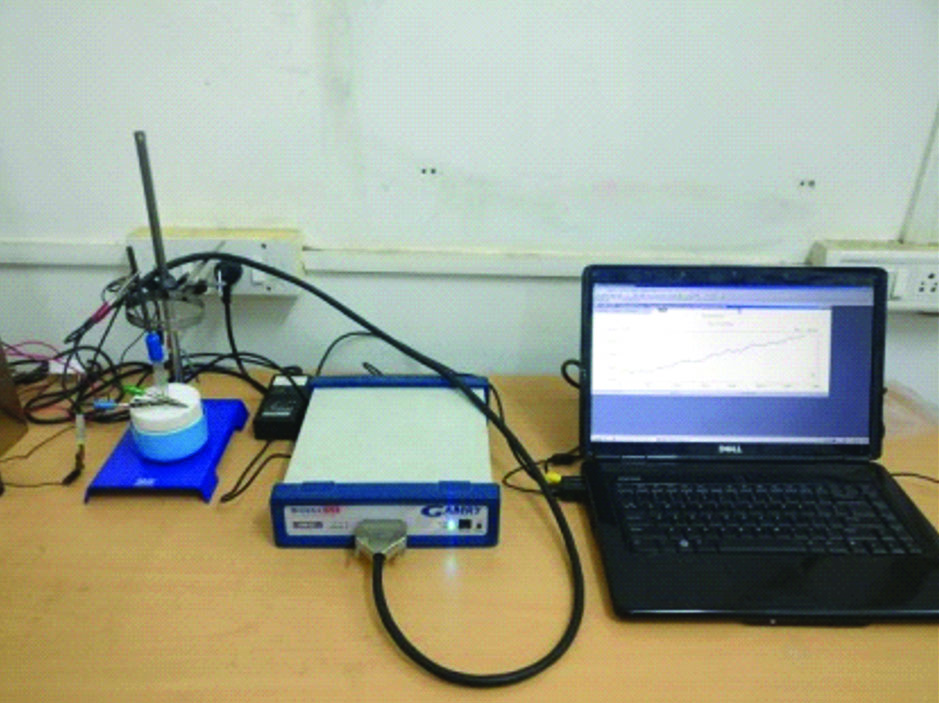
Corrosion process was carried out using a potentiostat (Gamry Interface 1000) and the values of corrosion current density, corrosion potential and pitting potential were noted using DC Corrosion Techniques Software, Cyclic Polarisation Technique (Phadke instruments, Mumbai). The corrosion rates were calculated using the Tafel analysis and potentiodynamic data [3]. Further, the surfaces were analysed under the metallurgical microscope (Labpro Compound metallurgical microscope, Celestron) for the surface changes and pitting [Table/Fig-5].
Metallurgical microscope used for observation of the surfaces.
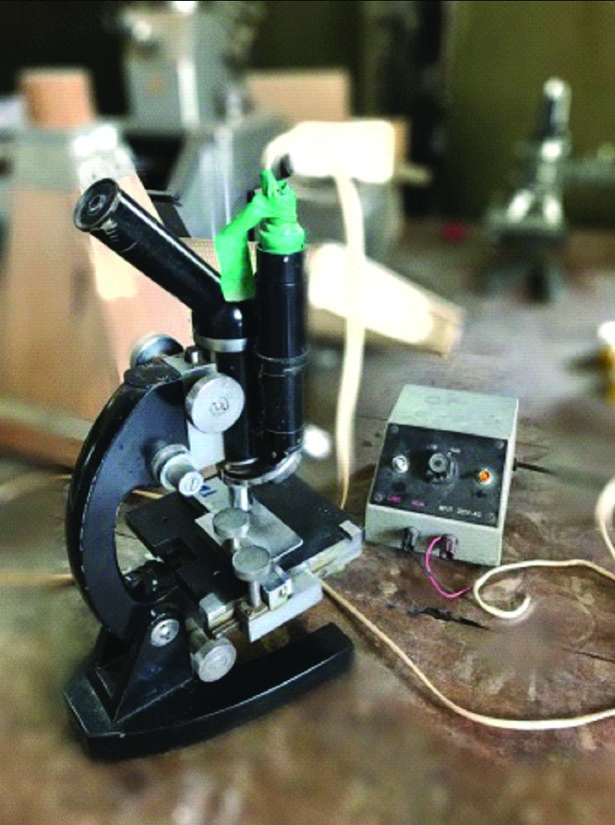
Statistical Analysis
No inferential statistics were applied as it was a pilot study and the sample size was very small.
Results
The corrosion current density (Icorr), corrosion potential (Ecorr) and the pitting potential (Epit) values were obtained for each of the specimen as shown in [Table/Fig-6].
Results obtained after the corrosion process.
(Ecorr: Corrosion potential; Icorr: Corrosion current density; Epit: Pitting potential
a- Value obtained for first bracket, b- value obtained for second bracket
Value in green depicts the coriander group, in yellow depicts the turmeric group and red depicts the red chilli group)
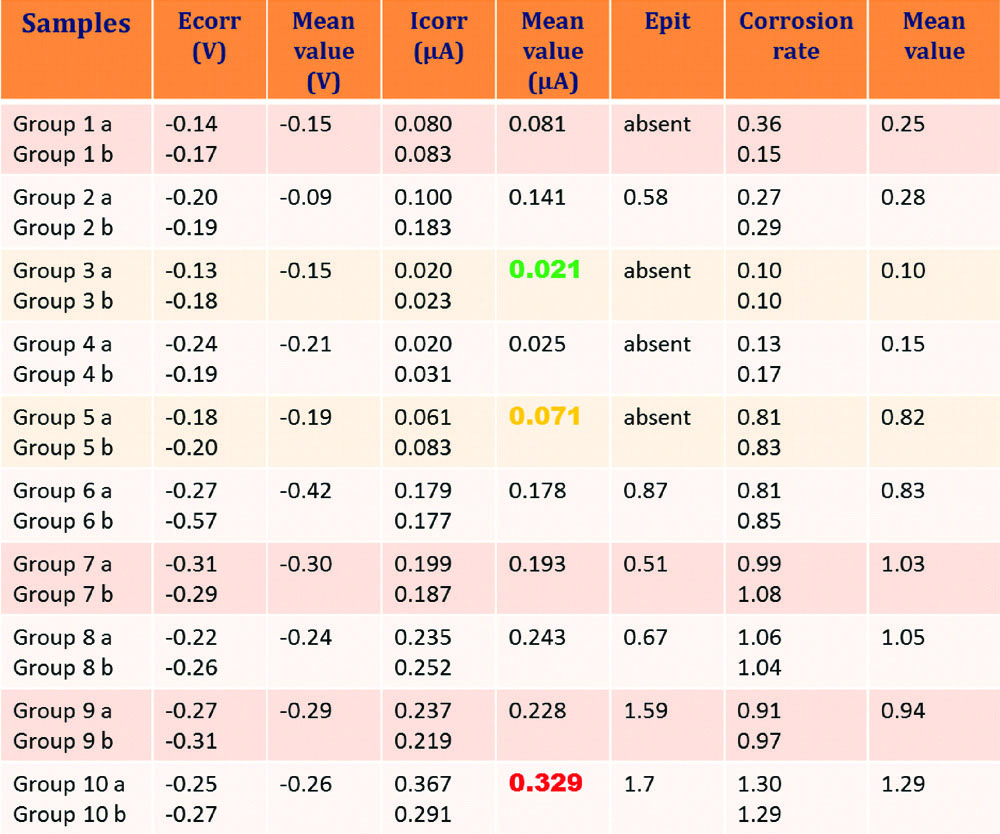
Increased corrosion process was seen on addition of salt to artificial saliva containing spices. The results showed higher Icorr values for the solutions containing salt suggestive of accelerated corrosion process. The mean values obtained showed higher Icorr values for Red chilli containing salt (0.329), red chilli solution (0.228) while minimum was seen in turmeric solution (0.071) and least was in coriander solution (0.021). Similarly, the corrosion rates obtained were least in coriander group (0.10) followed by turmeric group (0.82) and highest in red chilli group (1.29).
[Table/Fig-7] shows the overlay of polarisation curves obtained for the specimens in spices with artificial saliva and [Table/Fig-8] shows the overlay of polarisation curves obtained for the specimens in spices with artificial saliva containing salt. These depict the polarisation cycle for each bracket in various solutions and relationship between the current generated in electrochemical cell and the electrode potential of the metal bracket.
Superimposition of Tafel plots for specimens in spices with artificial saliva.
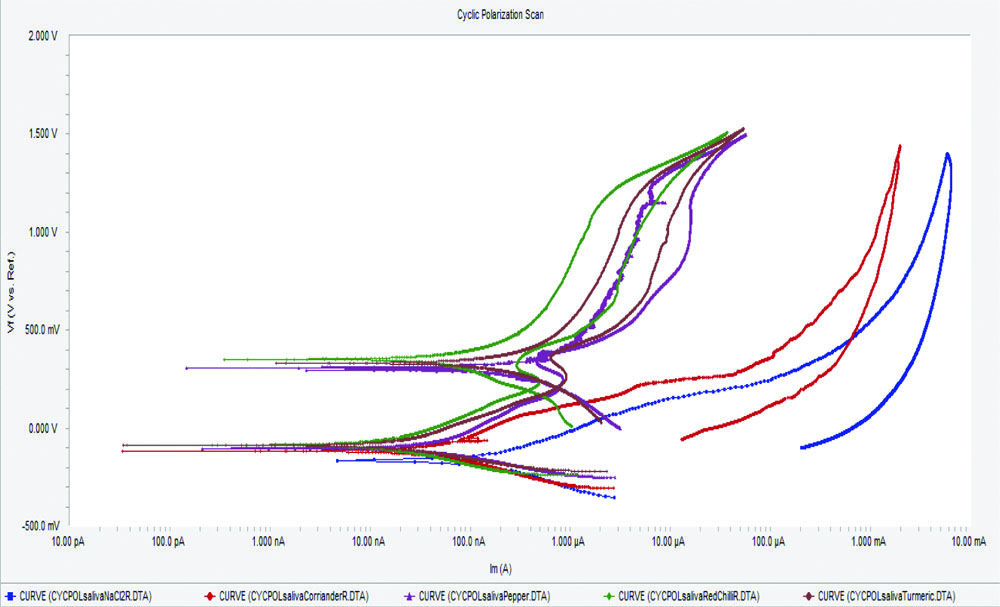
Superimposition of Tafel plots obtained for specimens in spices with artificial saliva containing salt.
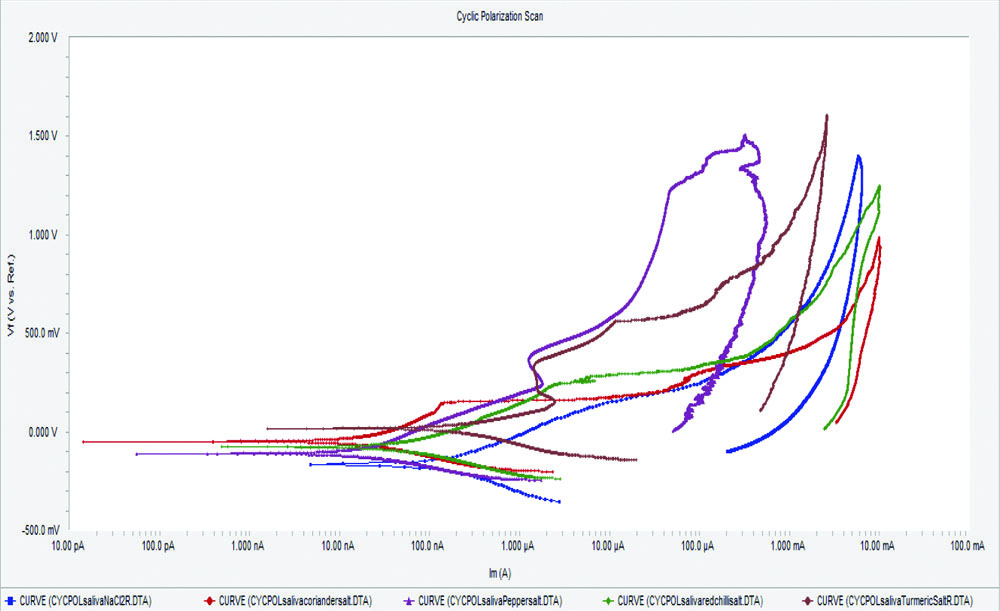
Based on the corrosion current values, the aggressiveness of the artificial saliva containing spices and salt can be arranged in decreasing order as follows: Red chilli > Black pepper > Artificial saliva >Turmeric >Coriander.
The observations under the metallurgical microscope matched with the electrochemical corrosion testing. Most pitting was evident in Red chilli group while least was observed in Coriander solution group.
[Table/Fig-9,10 and 11] show the surfaces of brackets under the metallurgical microscope.
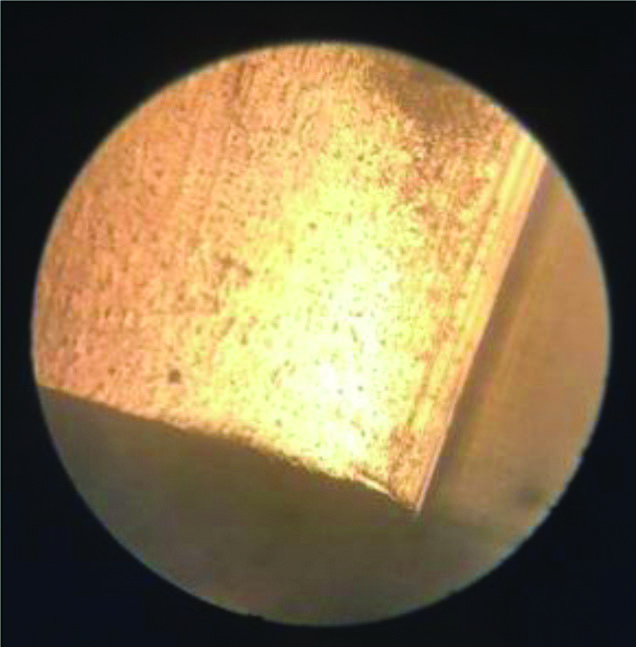
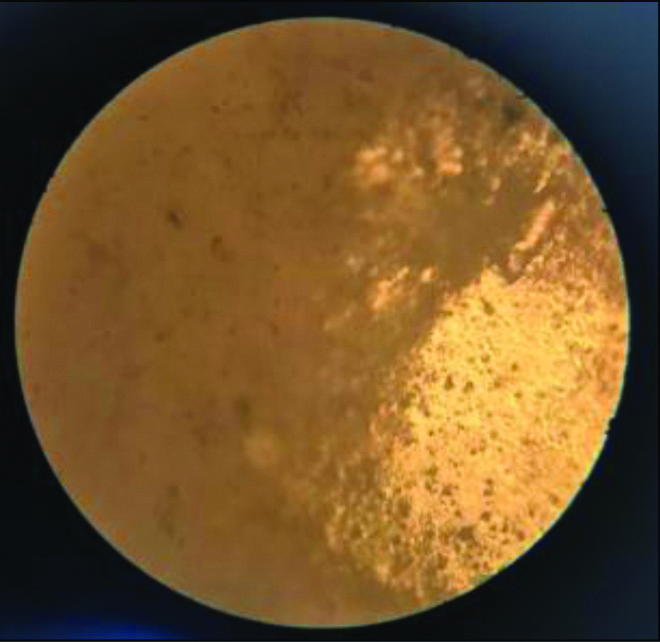
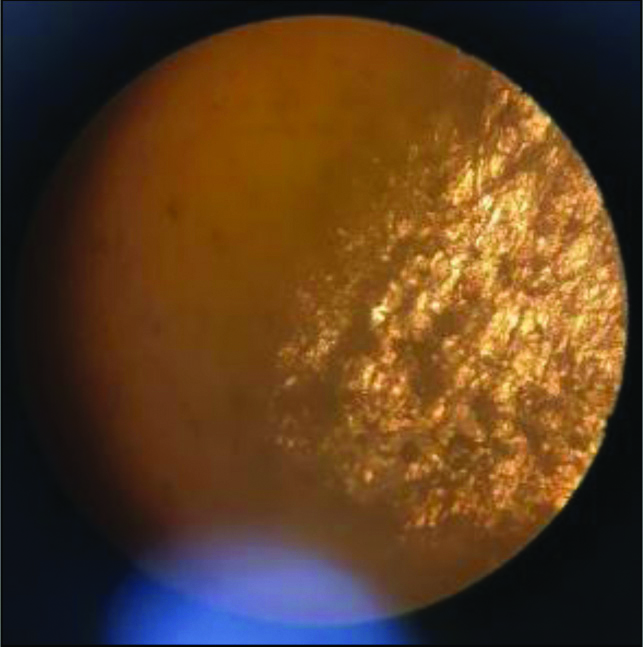
Discussion
Biodegradation of metal alloys is favoured by the oral environment due to the ionic, thermal, microbiological and enzymatic conditions [2]. Spices are made of complex mixtures of various organic substances and minerals, complicating it to understand about any particular component responsible for corrosion behaviour [3]. The curative properties of dietary spices have been seen in Rigveda and Atharvaveda and known to be the earliest records of use of herbs in medicine in India [4].
Corrosion causes release of metallic ions causing allergic reactions as well as deterioration of metallic appliances leading to failures. In a study conducted by Kim H et al., showed that nickel-titanium and stainless steel wires are susceptible to pitting and corrosion [5]. Mahato N et al., compared the effect of dietary spices on pitting behaviour of stainless steel bands and found that spices like cinnamon, cumin, red chilli and turmeric with added salt caused pitting while coriander inhibited pitting [6]. Also, in a study by Saporeti MP et al., showed that cobalt-chromium alloy underwent greatest corrosion whereas pure titanium alloys and steel alloys presented greatest corrosion resistance and presence of fluoride negatively affected the corrosion resistance [7]. Study by Santos A et al., found that treatment time, debris/biofilm influenced the chemical-physical properties of orthodontic brackets and arch wires [2]. In a study by Hussain S et al., concluded that biodegradation and corrosion resistance depends on the manufacturing process, nature of alloy and surface features of the appliance [8].
Chaturvedi TP and Dubey RS, found that titanium wires degraded when immersed in solution of toothpaste and chocolate in artificial saliva [9]. The study by Chaturvedi TP showed similar results obtained in present study where corrosion of orthodontic brackets was assessed in different spices. It was seen that spices such as turmeric and coriander were effective in reducing corrosion whereas red chilli and black pepper enhanced it. It was also noted that addition of salt increased the corrosion process [3]. Similarly, in a study by Sharma MR et al., where they assessed the effect of fruit juices and chloride ions on the corrosion behaviour of orthodontic archwire, found increased rate in corrosion with fruit juices and addition of salt showed pitting [10].
Sugisawa H et al., in their study found that titanium nitride plating on orthodontic wires improved the corrosion resistance of the wires and lessened pitting of the wire surface [11]. This was beneficial as it reduced the frictional forces. Zhang X et al., found that laser treatment refined the grain as well as enhanced microhardness of the 316L orthodontic bracket at certain heat input [12]. Trolić IM et al., concluded that effect of probiotic supplement depended on the type of coating of NiTi archwire where rhodium coated alloy showed higher corrosion in saliva than nitrified alloy and uncoated alloy [13].
Various factors affect the corrosion process of metallic brackets in the oral cavity. Spices, being an indispensible part of diet also affect the corrosion process. Having a thorough knowledge of this can help in preventing failures of orthodontic appliances and improve their shelf-life. With newer advances in orthodontic materials, it can be beneficial to include the newer materials in clinical practice.
Limitation
Being an in-vitro pilot study it cannot completely simulate the oral environment and the conditions. Moreover, the study was conducted on a small-scale, hence further studies are required for better and in depth understanding. Subjective observation of the samples was carried out due to resource constraint and availability, restricting a superior outcome which would have been possible with use of advanced instruments for assessment.
Conclusion
It is evident that oral environment greatly affects the corrosion behaviour of orthodontic appliances. It is difficult to simulate the oral environment entirely. Corrosion is a slow process affected by numerous factors spices being one of them. It can be seen that spices such as Salt, Red chillies and Black pepper have been found to enhance corrosion process while Turmeric and Coriander reduced corrosion. Suggestive additives in diet along with various other measures may be helpful in increasing the life of Orthodontic brackets and evict their failure during treatment as they affect the corrosion process.